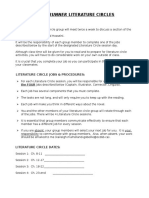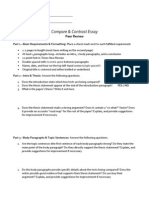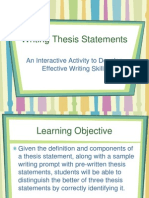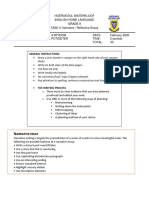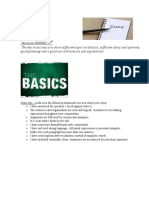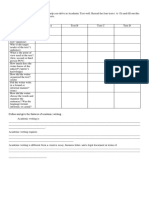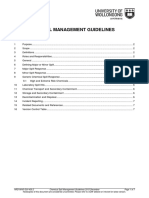0 ratings0% found this document useful (0 votes)
175 viewsParaphrasing PDF
Paraphrasing PDF
Uploaded by
Thuy DuongParaphrasing is your own rendition of essential information and ideas expressed by someone else. It is better than quoting information from an undistinguished passage. Only about 10% of your final manuscript should appear as directly quoted. Use quotation marks to identify any unique term or phraseology.
Copyright:
© All Rights Reserved
Available Formats
Download as PDF, TXT or read online from Scribd
Paraphrasing PDF
Paraphrasing PDF
Uploaded by
Thuy Duong0 ratings0% found this document useful (0 votes)
175 views3 pagesParaphrasing is your own rendition of essential information and ideas expressed by someone else. It is better than quoting information from an undistinguished passage. Only about 10% of your final manuscript should appear as directly quoted. Use quotation marks to identify any unique term or phraseology.
Original Title
PARAPHRASING.pdf
Copyright
© © All Rights Reserved
Available Formats
PDF, TXT or read online from Scribd
Share this document
Did you find this document useful?
Is this content inappropriate?
Paraphrasing is your own rendition of essential information and ideas expressed by someone else. It is better than quoting information from an undistinguished passage. Only about 10% of your final manuscript should appear as directly quoted. Use quotation marks to identify any unique term or phraseology.
Copyright:
© All Rights Reserved
Available Formats
Download as PDF, TXT or read online from Scribd
Download as pdf or txt
0 ratings0% found this document useful (0 votes)
175 views3 pagesParaphrasing PDF
Paraphrasing PDF
Uploaded by
Thuy DuongParaphrasing is your own rendition of essential information and ideas expressed by someone else. It is better than quoting information from an undistinguished passage. Only about 10% of your final manuscript should appear as directly quoted. Use quotation marks to identify any unique term or phraseology.
Copyright:
© All Rights Reserved
Available Formats
Download as PDF, TXT or read online from Scribd
Download as pdf or txt
You are on page 1of 3
PARAPHRASING
The Writing Centre
Department of English
1
1. Paraphrase: Write it in Your Own Words
Learn to borrow from a source without plagiarizing. For more information on paraphrasing, as
well as other ways to integrate sources into your paper, see the Purdue OWL handout Quoting,
Paraphrasing, and Summarizing. For more information about writing research papers, see our
workshop on this subject. Purdue students will want to make sure that they are familiar with
Purdue's official academic dishonesty policy as well as any additional policies that their
instructor has implemented. Another good resource for understanding plagiarism is the WPA
Statement on Plagiarism.
A paraphrase is...
your own rendition of essential information and ideas expressed by someone else, presented
in a new form.
one legitimate way (when accompanied by accurate documentation) to borrow from a source.
a more detailed restatement than a summary, which focuses concisely on a single main idea.
Paraphrasing is a valuable skill because...
it is better than quoting information from an undistinguished passage.
it helps you control the temptation to quote too much.
the mental process required for successful paraphrasing helps you to grasp the full meaning
of the original.
6 Steps to Effective Paraphrasing
1. Reread the original passage until you understand its full meaning.
2. Set the original aside, and write your paraphrase on a note card.
3. Jot down a few words below your paraphrase to remind you later how you envision using
this material. At the top of the note card, write a key word or phrase to indicate the
subject of your paraphrase.
4. Check your rendition with the original to make sure that your version accurately
expresses all the essential information in a new form.
5. Use quotation marks to identify any unique term or phraseology you have borrowed
exactly from the source.
6. Record the source (including the page) on your note card so that you can credit it easily if
you decide to incorporate the material into your paper.
PARAPHRASING
The Writing Centre
Department of English
2
SOME EXAMPLES TO COMPARE
The original passage:
Students frequently overuse direct quotation in taking notes, and as a result they overuse
quotations in the final [research] paper. Probably only about 10% of your final manuscript
should appear as directly quoted matter. Therefore, you should strive to limit the amount of exact
transcribing of source materials while taking notes. From Lester, James D. Writing Research
Papers. 2nd ed. (1976): 46-47.
A legitimate paraphrase:
In research papers students often quote excessively, failing to keep quoted material down to a
desirable level. Since the problem usually originates during note taking, it is essential to
minimize the material recorded verbatim (Lester 46-47).
An acceptable summary:
Students should take just a few notes in direct quotation from sources to help minimize the
amount of quoted material in a research paper (Lester 46-47).
A plagiarized version:
Students often use too many direct quotations when they take notes, resulting in too many of
them in the final research paper. In fact, probably only about 10% of the final copy should
consist of directly quoted material. So it is important to limit the amount of source material
copied while taking notes.
After reviewing this handout, try an exercise on paraphrasing.
2. Paraphrasing Exercise
Directions: On a separate piece of paper, write a paraphrase of each of the following passages.
Try not to look back at the original passage.
1. "The Antarctic is the vast source of cold on our planet, just as the sun is the source of our heat,
and it exerts tremendous control on our climate," [Jacques] Cousteau told the camera. "The cold
ocean water around Antarctica flows north to mix with warmer water from the tropics, and its
upwellings help to cool both the surface water and our atmosphere. Yet the fragility of this
regulating system is now threatened by human activity." From "Captain Cousteau," Audubon
(May 1990):17.
PARAPHRASING
The Writing Centre
Department of English
3
2. Drinking was against the law in the twenties, and these regulations were considered a bad joke
because everyone knew of a local bar where liquor could be had. They were the years when
organized crime ruled the cities, and the police seemed powerless to do anything against it.
Classical music was forgotten while jazz spread throughout the land, and men like Bix
Beiderbecke, Louis Armstrong, and Count Basie became the heroes of the young. The flapper
was born in the twenties, and with her bobbed hair and short skirts, she symbolized, perhaps
more than anyone or anything else, America's break with the past. From Kathleen Yancey,
English 102 Supplemental Guide (1989): 25.
3. Of the more than 1000 bicycling deaths each year, three-fourths are caused by head injuries.
Half of those killed are school-age children. One study concluded that wearing a bike helmet can
reduce the risk of head injury by 85 percent. In an accident, a bike helmet absorbs the shock and
cushions the head. From "Bike Helmets: Unused Lifesavers," Consumer Reports (May 1990):
348.
3. Paraphrasing Exercise: Possible Answers
Here are sample answers for the paraphrasing exercise:
1. According to Jacques Cousteau, the activity of people in Antarctica is jeopardizing a delicate
natural mechanism that controls the earth's climate. He fears that human activity could interfere
with the balance between the sun, the source of the earth's heat, and the important source of cold
from Antarctic waters that flow north and cool the oceans and atmosphere ("Captain Cousteau"
17).
2. During the twenties, lawlessness and social nonconformity prevailed. In cities organized crime
flourished without police interference, and, in spite of nationwide prohibition of liquor sales,
anyone who wished to buy a drink knew where to get one. Musicians like Louis Armstrong
become favorites, particularly among young people, as many turned away from highly
respectable classical music to jazz. One of the best examples of the anti-traditional trend was the
proliferation of young "flappers," women who rebelled against custom by cutting off their hair
and shortening their skirts (Yancey 25).
3. The use of a helmet is the key to reducing bicycling fatalities, which are due to head injuries
75% of the time. By cushioning the head upon impact, a helmet can reduce accidental injury by
as much as 85%, saving the lives of hundreds of victims annually, half of whom are school
children ("Bike Helmets" 348).
You might also like
- Gud27essmww Lavadora y Secadora General Electric PDFDocument81 pagesGud27essmww Lavadora y Secadora General Electric PDFEdison EspinalNo ratings yet
- Synthesis Essay OutlineDocument3 pagesSynthesis Essay OutlineNick CasamassimaNo ratings yet
- The Kite Runner Literature CirclesDocument11 pagesThe Kite Runner Literature Circlesapi-308070012No ratings yet
- ESL Summary Writings Set 1Document15 pagesESL Summary Writings Set 1erin100% (1)
- CRAAP Test Worksheet - Water PollutionDocument2 pagesCRAAP Test Worksheet - Water PollutioncheyNo ratings yet
- Paraphrasing Exercise PDFDocument3 pagesParaphrasing Exercise PDFThuy Duong100% (5)
- Northern Ireland's Street Art: Video UK - Exercises: 1. Preparation: MatchingDocument2 pagesNorthern Ireland's Street Art: Video UK - Exercises: 1. Preparation: MatchingThuy DuongNo ratings yet
- Meridian AHR Tilt AdjustDocument28 pagesMeridian AHR Tilt AdjustHomerKhanNo ratings yet
- BagsDocument53 pagesBagsArt SM100% (3)
- Paraphrasing PDFDocument3 pagesParaphrasing PDFhasanNo ratings yet
- Type of Sentences in An EsayDocument4 pagesType of Sentences in An EsayJosé JaimesNo ratings yet
- Writing IBDP English B SLHL FE2020 KognityDocument1 pageWriting IBDP English B SLHL FE2020 KognityEkaterina Julià KonakovNo ratings yet
- English III Finding-Evaluating SourcesDocument12 pagesEnglish III Finding-Evaluating Sourcesapi-251057443No ratings yet
- Read The Text and Answer The Questions English Academic Writing: The "A" PaperDocument2 pagesRead The Text and Answer The Questions English Academic Writing: The "A" PaperКсенияNo ratings yet
- Summary of Punctuation MarksDocument11 pagesSummary of Punctuation MarksDimitris Mentes100% (1)
- Argumentative Essay WritingDocument5 pagesArgumentative Essay WritingRiefki FajarNo ratings yet
- PAT Essay Writing Narrative For TestingDocument89 pagesPAT Essay Writing Narrative For TestingИрина ПроковскаяNo ratings yet
- Synthesis Essay ExampleDocument4 pagesSynthesis Essay ExampleChristian FrankNo ratings yet
- Gatsby Final Project Assignment SheetDocument3 pagesGatsby Final Project Assignment Sheetapi-242602625No ratings yet
- Course Syllabus Aa ReadingDocument9 pagesCourse Syllabus Aa Readingapi-297204727No ratings yet
- SHEG - Evaluating SourcesDocument2 pagesSHEG - Evaluating SourcestheriaultnNo ratings yet
- Topic Sentence, Elements of Paragraph, Writing SentencesDocument4 pagesTopic Sentence, Elements of Paragraph, Writing SentencesGal GarciaNo ratings yet
- How To Write Paragraph 1Document14 pagesHow To Write Paragraph 1jojinjo100% (1)
- English 9 - Unit 8 - Lesson 1 - The Persuasive EssayDocument17 pagesEnglish 9 - Unit 8 - Lesson 1 - The Persuasive EssayTeacher MikkaNo ratings yet
- Compare and Contrast Peer ReviewDocument2 pagesCompare and Contrast Peer Reviewapi-212361252100% (1)
- Thesis Statement PracticDocument36 pagesThesis Statement PracticHanna HassanNo ratings yet
- Expository Writing Worksheet PDFDocument2 pagesExpository Writing Worksheet PDFGlyndaNo ratings yet
- Model EssayDocument3 pagesModel EssayMarcela CostaNo ratings yet
- La - Literature - The Time Machine - Chapter 6Document6 pagesLa - Literature - The Time Machine - Chapter 6api-238179390No ratings yet
- Synthesis Essay Assignment InfoDocument3 pagesSynthesis Essay Assignment InfoelgoldenNo ratings yet
- 2020 GR 8 Task 3 EssayDocument6 pages2020 GR 8 Task 3 EssayRandom ReplaysNo ratings yet
- Ielts Bar Graph EssayDocument6 pagesIelts Bar Graph Essaytabby9529No ratings yet
- Guide To Writing A Synthesis EssayDocument2 pagesGuide To Writing A Synthesis Essayapi-237174033No ratings yet
- 2017 Book Writing IfelpDocument43 pages2017 Book Writing IfelpReslyn GarciaNo ratings yet
- Thesis (5 Paragraph Essay) Planning SheetDocument6 pagesThesis (5 Paragraph Essay) Planning SheetPauline AnstissNo ratings yet
- 1062-3a How To Find Main IdeasDocument6 pages1062-3a How To Find Main IdeasdyrahNo ratings yet
- Tap TOEFL MidtermDocument6 pagesTap TOEFL MidtermNguyen Viet LovesUlis100% (1)
- Assignment#1 Reading ComprehensionDocument4 pagesAssignment#1 Reading Comprehensionpipo100% (1)
- English 4C - Independent Study Outline: These Dates Are Subject To ChangeDocument6 pagesEnglish 4C - Independent Study Outline: These Dates Are Subject To Changeapi-476730596No ratings yet
- Expository Essay Outline FormDocument2 pagesExpository Essay Outline FormMohammad ZamanNo ratings yet
- Essay Evaluation FormDocument3 pagesEssay Evaluation Formguest1957No ratings yet
- Topic SentenceDocument2 pagesTopic SentenceTin Tin IINo ratings yet
- Hills Like White ElephantsDocument9 pagesHills Like White ElephantsGae Artates AlmarezNo ratings yet
- Summary Writing: Reader EnglishDocument16 pagesSummary Writing: Reader EnglishBabNo ratings yet
- IELTS Writing 1 PreparationDocument11 pagesIELTS Writing 1 PreparationokaberntrNo ratings yet
- Evaluating Sources (Activity) - ABUGADocument2 pagesEvaluating Sources (Activity) - ABUGASeungwoo ParkNo ratings yet
- Chapter 7 - Writing Cause and Effect EssaysDocument33 pagesChapter 7 - Writing Cause and Effect EssaysaalshehabNo ratings yet
- Compare and Contrast EssaysDocument18 pagesCompare and Contrast EssaysMaryam AleemNo ratings yet
- Rhetorical Devices: What Is Rhetoric?Document4 pagesRhetorical Devices: What Is Rhetoric?John LukezicNo ratings yet
- Backup of Paraphrasing ExerciseDocument1 pageBackup of Paraphrasing ExerciseLawrence Briones IcasianoNo ratings yet
- Essay Writing (IELTS)Document3 pagesEssay Writing (IELTS)Gigi GuastellaNo ratings yet
- Ela Grade9 Curriculum Semester1 2016 DraftDocument20 pagesEla Grade9 Curriculum Semester1 2016 Draftapi-238019285No ratings yet
- Activity 1: Fill It AcademicallyDocument9 pagesActivity 1: Fill It AcademicallyPeHmyang Pineda DielNo ratings yet
- How To Write An Argumented EssayDocument35 pagesHow To Write An Argumented EssayFarhad UllahNo ratings yet
- Agree - Disagree Argument Essay PTEDocument4 pagesAgree - Disagree Argument Essay PTEShailendra SinhaNo ratings yet
- American Literature Study GuideDocument22 pagesAmerican Literature Study Guidehoanghuy2094No ratings yet
- English 11 Forms of WritingDocument2 pagesEnglish 11 Forms of Writingapi-266273096No ratings yet
- Essential Academic English (EAE) Paraphrasing Exercises Exercise 1 Paraphrase The Sentences BelowDocument1 pageEssential Academic English (EAE) Paraphrasing Exercises Exercise 1 Paraphrase The Sentences BelowAFiqah Nazirah JailaniNo ratings yet
- Plan 2. Write 3. Check: A Kwikguide To Analysing PoetryDocument3 pagesPlan 2. Write 3. Check: A Kwikguide To Analysing PoetryAhsan AliNo ratings yet
- English 1 The Scarlet Ibis Essay PromptDocument4 pagesEnglish 1 The Scarlet Ibis Essay Promptapi-332181833No ratings yet
- Paragraph Writing - Compare & ContrastDocument22 pagesParagraph Writing - Compare & ContrastKk KhanNo ratings yet
- La - Literature - The Time Machine - Chapter 5Document6 pagesLa - Literature - The Time Machine - Chapter 5api-238179390No ratings yet
- Paragrapgh To EssayDocument20 pagesParagrapgh To EssayAlexandra Angulo HernandezNo ratings yet
- Comma Ellipsis and Dash UseDocument25 pagesComma Ellipsis and Dash UseTrinity MagtotoNo ratings yet
- AP English Language and Composition Exam: Guide for EssaysFrom EverandAP English Language and Composition Exam: Guide for EssaysRating: 1 out of 5 stars1/5 (3)
- Rural and Urban - VSWDocument7 pagesRural and Urban - VSWThuy DuongNo ratings yet
- Gram - Comparative, Enough, So Such, DegreeDocument15 pagesGram - Comparative, Enough, So Such, DegreeThuy DuongNo ratings yet
- Health - RSW Topic SentenceDocument17 pagesHealth - RSW Topic SentenceThuy DuongNo ratings yet
- Klimaproblemet I NorgeDocument1 pageKlimaproblemet I NorgeThuy DuongNo ratings yet
- Science Worksheet Energy For Life Ref: SY1250T9337W2778: Name DateDocument9 pagesScience Worksheet Energy For Life Ref: SY1250T9337W2778: Name DateThuy DuongNo ratings yet
- FCE Collocations 2Document2 pagesFCE Collocations 2Thuy Duong100% (1)
- Scholastic Learning Zone Quick Start Guide 20150423Document16 pagesScholastic Learning Zone Quick Start Guide 20150423Thuy DuongNo ratings yet
- 810202-1 New Farm Start-Up GuideDocument59 pages810202-1 New Farm Start-Up GuideThuy DuongNo ratings yet
- Using Prepositions - IELTS Writing Task 1 PDFDocument3 pagesUsing Prepositions - IELTS Writing Task 1 PDFThuy DuongNo ratings yet
- Quick Guide: Practising Academic Integrity: Blending Paraphrases Into Your WritingDocument9 pagesQuick Guide: Practising Academic Integrity: Blending Paraphrases Into Your WritingThuy DuongNo ratings yet
- Negotiations Promo1Document0 pagesNegotiations Promo1Thuy Duong100% (1)
- Northern Ireland's Street Art: Video UK - Answers: 1. Preparation: MatchingDocument1 pageNorthern Ireland's Street Art: Video UK - Answers: 1. Preparation: MatchingThuy DuongNo ratings yet
- Vocabulary FlashcardsDocument50 pagesVocabulary Flashcardsjustttka100% (22)
- Apologies, Excuses and PromisesDocument5 pagesApologies, Excuses and PromisesThuy DuongNo ratings yet
- TOEIC GrammarDocument45 pagesTOEIC GrammarThuy Duong100% (2)
- 3488R Sign LanguageDocument11 pages3488R Sign LanguageThuy DuongNo ratings yet
- Figure 1-301 Gasket Eliminator Application: Series 60 Service ManualDocument2 pagesFigure 1-301 Gasket Eliminator Application: Series 60 Service ManualvictoverNo ratings yet
- Jangan Panik & Jangan CemasDocument18 pagesJangan Panik & Jangan Cemasjhj01No ratings yet
- Dancer of Shamahka - Armen OhanianDocument280 pagesDancer of Shamahka - Armen OhanianManukSuren100% (1)
- SWP - Excavator Safety LockoutDocument3 pagesSWP - Excavator Safety LockoutTushiro K. HimuraNo ratings yet
- HarrodsDocument2 pagesHarrodsCristina BobocNo ratings yet
- Pelle The Conqueror - Volume 03 by Nexø, Martin Andersen, 1869-1954Document245 pagesPelle The Conqueror - Volume 03 by Nexø, Martin Andersen, 1869-1954Gutenberg.orgNo ratings yet
- 5S CQI GQA ChecklistDocument4 pages5S CQI GQA ChecklistMostafa Abd ElalemNo ratings yet
- The Effects of Korean Fashion To The Filipino YouthDocument6 pagesThe Effects of Korean Fashion To The Filipino YouthJaneth MarcelinoNo ratings yet
- DMir 1912 05 04 001-InqueritoDocument16 pagesDMir 1912 05 04 001-InqueritoTitanicwareNo ratings yet
- Linen FactsDocument2 pagesLinen Factskiddykishore100% (3)
- AddiToys SEVERUS SNAPEDocument12 pagesAddiToys SEVERUS SNAPENyrylaNo ratings yet
- Union Exports - List of Customers: Annexure-1Document3 pagesUnion Exports - List of Customers: Annexure-1faraz85No ratings yet
- Prepositions of Place Interactive GamesDocument17 pagesPrepositions of Place Interactive GamescytronNo ratings yet
- HOA3Document6 pagesHOA3JHOSSA MAE EPONDULANNo ratings yet
- Zero Hour - Steve SheffieldDocument226 pagesZero Hour - Steve SheffieldkarinamoduNo ratings yet
- Officer Tries To Make Charges Despite No CrimeDocument26 pagesOfficer Tries To Make Charges Despite No CrimeLas Vegas Review-JournalNo ratings yet
- Closet Revolution: (Simple Business Plan)Document3 pagesCloset Revolution: (Simple Business Plan)Elaiza LozanoNo ratings yet
- WrittingsDocument4 pagesWrittingsTOCTE CALERO KERLY JHOMAIRANo ratings yet
- ENGLISH Use in Textile EngineeringDocument63 pagesENGLISH Use in Textile EngineeringDhrubo Adhikary100% (1)
- TDS Pattex Repair Extreme 031223Document2 pagesTDS Pattex Repair Extreme 031223jfmanNo ratings yet
- Chemical Spill Management GuidelinesDocument7 pagesChemical Spill Management GuidelinesAvyan KelanNo ratings yet
- Section A: Ujian Prestasi 2 English Year 2Document12 pagesSection A: Ujian Prestasi 2 English Year 2Mama ShamerNo ratings yet
- RaichuDocument7 pagesRaichuRegina Brégola100% (2)
- CADDocument4 pagesCADAnonymous dv70pHNNo ratings yet
- Draka x27 S Heat 40 Sidonions 41 - Olivia RileyDocument184 pagesDraka x27 S Heat 40 Sidonions 41 - Olivia RileyZoya HaqNo ratings yet
- Manual Secadora Indesit ISL65C ISL66CX (DRYER INSTRUCTION BOOKLET)Document84 pagesManual Secadora Indesit ISL65C ISL66CX (DRYER INSTRUCTION BOOKLET)melkafoseoNo ratings yet
- Operating Manual Smart ForfourDocument266 pagesOperating Manual Smart ForfourSumer SachirNo ratings yet


